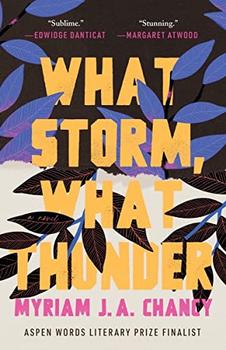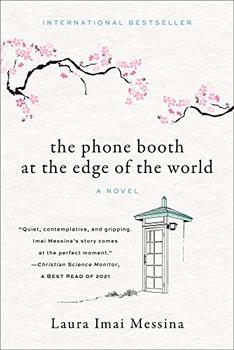Summary | Excerpt | Reviews | Beyond the book | Read-Alikes | Genres & Themes | Author Bio

What Storm, What Thunder illuminates life in Haiti during and after the massive earthquake on January 12, 2010. Later called the "Event," or "Douz" (the number 12 in Haitian Creole), it took more than 250,000 lives. Aftershocks — emotional, economic, political, humanitarian, geographic — continue to the present day. Despite the backdrop of trauma, this book drew me in on many levels.
Author Myriam J. A. Chancy was born in Haiti and retains strong ties. Her intimate knowledge of the country's landscape, people, culture and history informs every page. Language throughout is descriptive, poetic and peppered with a few Creole words: "The pool at the Hotel de la Montagne was in the form of what the people called a pois rouge, or red kidney bean. The food was also Haitian…chicken in a spicy sauce called ti malis, little devil or pleasure, that made the tongue dance."
Haiti's contemporary problems are often sensationalized by international news headlines. Chancy reveals a fragile and nuanced world of people surviving in dire circumstances determined to rebuild their lives and communities. She consistently draws parallels to our common humanity, the universal needs of food, water, sanitation and safe shelter. For Haitians living in exile, the novel may stir or restore memories, not only of tragedy, but of vibrant communities, culture and spirit that endure. In this sense, What Storm, What Thunder reads like a love story to a place and its people.
Organized as a series of vignettes that could stand alone, chapters are narrated by alternating first-person characters. Storylines and fates interconnect in often unexpected ways, propelling the dramatic tension. Multiple points of view bring readers in close to lived experience during catastrophe. Each character reveals thin slices of trauma that, in total, could be overwhelming. But in short chapters, I found myself fully immersed in each character's emotions and fate.
The author also layers in elements of political economy, globalization, poverty and privilege to excavate important and complex differences in how diverse Haitian people managed the devastation.
We meet Ma Lou, a woman who runs a market stall in Port-au-Prince. Raised a Catholic, she also embraces elements of traditional vodou. The earthquake shakes her faith but she carries on with business, despite the fact that many of her friends, neighbors and family members perished in the disaster. Her son, Richard, lives in France, where he's a wealthy executive for a multinational bottled water company. As he describes, "It's my challenge to package something that everyone should be able to raise from the earth but can't—they have other things to do—and sell it back to them, as if it had never been theirs in the first place." Richard's daughter, Anne, works as an architect in Rwanda, but returns to Haiti to reconnect with her grandmother, Ma Lou, and eventually volunteers in rebuilding efforts.
Schoolgirl Taffia and her brother Paul lose their parents, friends and neighbors: "People who had been laughing and fighting one second were reduced to lifelessness, their bodies tossed by the side of the road until a truck could pick them up and take them away, later, much later. The sound covered us all, like vibrating wings of some giant hummingbird." The siblings end up at an Internally Displaced Persons (IDP) tent camp, where their fates diverge. Paul joins a youth gang and Taffia comes of age as one of the strong women working to hold the IDP community together. Taffia's elder brother, Didier, is a taxi driver in Boston, emblematic of thousands of expatriate Haitians who send remittances to family back home.
Young parents Sara and Olivier endure the loss of their children and displacement to the tent camp, where clean water, food and dignity remain scarce. Their 11-year-old son Jonas, who also narrates part of the book, has inherited his father's passion for mathematical thinking. In one chapter, Jonas contemplates the number 12.
"Divided by four: it's the number of hours it takes Papa and some other men from the neighborhood, old and young ones, to get me out from under the broken wall, the number of fractures the medic counts in my leg before he stops counting and turns to tell my father the bottom of it will have to come off. It's the number of minutes it takes for me to add up that I'll never become a soccer star…"
Each character has a distinctive voice, to explore and describe their own ambitions, regrets, passion, healing and growth. Sometimes, the disaster also bestows second chances: the possibility to reinvent a life that was not functioning well before.
Themes like natural disaster, poverty, cultural identity, endurance, community building, legacy of enslavement, family ties and ordinary heroes offer generous starting places for book group, community and classroom discussion.
![]() This review was originally published in The BookBrowse Review in January 2022, and has been updated for the
September 2022 edition.
Click here to go to this issue.
This review was originally published in The BookBrowse Review in January 2022, and has been updated for the
September 2022 edition.
Click here to go to this issue.

If you liked What Storm, What Thunder, try these:

by Kevin Jared Hosein
Published 2024
From an unforgettable new voice in Caribbean literature, a sweeping story of two families colliding in 1940s Trinidad - and a chilling mystery that shows how interconnected their lives truly are.

The Phone Booth at the Edge of the World
by Laura Imai Messina
Published 2022
The international bestselling novel sold in 21 countries, about grief, mourning, and the joy of survival, inspired by a real phone booth in Japan with its disconnected "wind" phone, a place of pilgrimage and solace since the 2011 tsunami.
Your guide toexceptional books
BookBrowse seeks out and recommends the best in contemporary fiction and nonfiction—books that not only engage and entertain but also deepen our understanding of ourselves and the world around us.